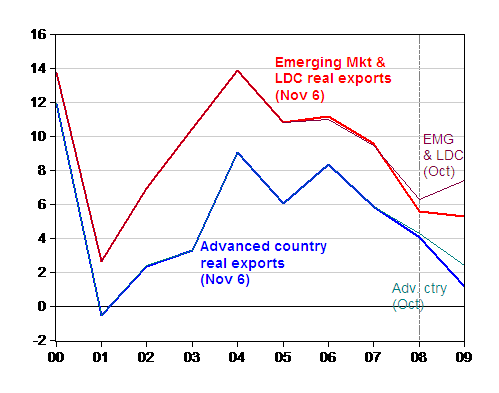Last Thursday, I had the opportunity to participate in a panel on Global Economic Crisis: The Untold Stories, sponsored by the Center for World Affairs and the Global Economy (WAGE). I was tasked with surveying the impact on the economy outside the borders of the United States — in 20 minutes.
Here’s the link to my presentation, but I reproduce one of the key slides here:

Figure 1: Growth rates of real goods and services exports (y/y), by country group. Source: IMF, WEO Oct. 2008 database; Nov. 6 WEO update.
What’s of greatest interest to me is how rapidly estimates of emerging market and LDC export growth were revised downward, going from the October to November projections. This only reinforces my view that the US slowdown will have a disproportionate impact on world trade given the drastic change in the role of the US consumer.
The other participants in the panel were Mark Copelovitch, Assistant Professor of Political Science and Public Affairs (my colleague at The La Follette School); Edward Friedman, Professor of Political Science; Darian Ibrahim, Assistant Professor of Law; and Mark Ready, Jeffrey J. Diermeier Chair of Finance.
Update, 11/25 12:30pm: Here is Mark Copelovitch’s presentation, where he discusses the politics of global financial governance and how they will shape policy responses to the crisis, including new national-level regulation, international regulatory harmonization, and reform of the International Monetary Fund.
I’ll post the link to the video when available.
Just a nit to pick.
The US consumer is not the one of last resort. He is the consumer of first resort. That is why the contageon has spread so rapidly. If the US consumer were the one of last resort, there would be consumers in other countries to take up the slack.
It is a small point, I know, but to ignore it is to ignore the mercantalist policies of Japan, China, Europe, etc. which on some level are a big part of this crisis.
As one who sees the problems of the world from the perspective of the harm done to the ability of the U.S. manufacturing sector by the large trade deficit, the reduction in exports throughout the world is hartening rather than discouraging.
In the recession of 2001-2002, consumption in the U.S. was maintained by the rapid drop in the Federal Funds rate froom 6% on Jan. 2001 to 2% by Dec. 2001. Credit continued to expand. But the consumers wanted bargins. So, more imports were consumed. This triggered an expansion of the trade deficiit.
Fortunately, the experience of 2001-2002 was not repeated. The potential for reducing the U.S. trade deficit is now quite real.
Buzzcut: I think the phraseology is (was) selected to emphasize the analogy to “lender of last resort” — and throughout 2000-05, as Europe and East Asia failed to consume, the US did indeed pick up the slack and consume.
W. Raymond Mills: I would prefer to look at the harm to the manufacturing sector as arising from the boom in nontradables arising from lax regulation, lax monetary policy and fiscal deficits in combination.
My stress on nontradables is a segue to my point that services are a big component of US exports; roughly one third (and if one thinks about the imported component of US exports, then the ratio is probably higher — see this post on vertical specialization).